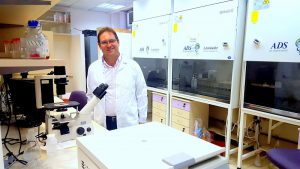Advancing Pressure Ulcer Research with Tissue-Engineered and Computational Models

Dr. Amit Gefen of Tel Aviv University
Pressure ulcers, or injuries to the skin and underlying tissue due to prolonged pressure on the body, are a common complication in patients confined to a wheelchair or bed for long periods of time, such as those with a spinal cord injury or elderly and infirm populations. In Dr. Amit Gefen’s Musculoskeletal Biomechanics Lab at Tel Aviv University, researchers are working to better understand pressure ulcers and related tissue injuries, such as diabetic foot ulcers. To achieve this goal, the team uses cell and tissue engineering approaches, as well as computer simulations, to reduce the need for animal model studies. Their work has helped advance the field of pressure ulcers and chronic wounds, translating into improvements in clinical care that have prevented patient mortality, massive surgical corrections and foot amputations.
The general aim of Dr. Gefen’s laboratory is to study the normal and pathological effects of biomechanical factors on the structure and function of human cells, tissues and organs. Their focus is on the musculoskeletal system and applications in chronic wound research. In particular, Dr. Gefen’s research interests include:
- Experimental and computational analysis of the mechanical behavior of hard and soft biological tissues
- Role of mechanical stress distribution within tissues in disease development
- Analysis of the kinematic and dynamic behavior of musculoskeletal structures
- Development of methodologies for computer planning, simulation and enhancement of medical treatments and surgical procedures
The findings of Dr. Gefen and his team have helped to shape the International Guidelines for the Prevention and Treatment of Pressure Ulcers, which is implemented in hospitals, nursing homes and other care facilities worldwide. Their research has also furthered basic understanding of pressure ulcers, in particular by strengthening the theory that internal tissue loads, rather than contact pressures between the body and external surfaces, should be used to predict tissue damage and that a patient’s individual anatomy has a critical influence on risk for chronic wound development.
This knowledge has been applied to the clinic. For example, the lab has introduced a real-time method for patient-specific monitoring of internal mechanical loads in soft tissue. The system has been employed to determine tissue loads in patients with spinal cord injuries, without interrupting their daily activities like typical home monitoring does. Similar systems have also been created to protect amputees’ residual limbs from injury, as well as to prevent diabetic patients from developing foot ulcers.
Research continues in the Gefen laboratory to further improve understanding, prevention and treatment of chronic wounds. For example, the lab is developing cellular-scale models of deep tissue injury. By studying the behavior of skeletal muscle cells, the team is hoping to characterize the mechanisms underlying the onset and progression of this injury; the specific processes leading to the formation of a deep tissue injury are still unknown. The team is also working to characterize risk factors for a deep tissue injury. In particular, they are using computational modeling to explore how abnormal body weight impacts injury development. Visit the group’s website for a full list of their current activities.
Dr. Gefen recently joined the Kerafast community by making available his laboratory’s Musculoskeletal Biomechanics Services. Scientists worldwide can put the lab’s facilities to use for their own experimental and computational studies of cells, tissues, organs and whole body biomechanics. Available services include:
- Analyzing the mechanical behavior of hard and soft biological tissues and biomaterials
- Developing cell and tissue model systems for studying acute and chronic injuries
- Designing and testing medical devices for preventing, diagnosing and treating chronic wounds
A full list of the available musculoskeletal biomechanics services can be found here.


